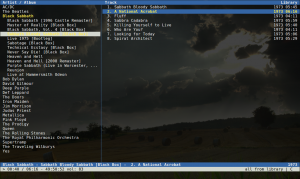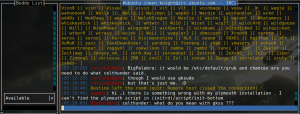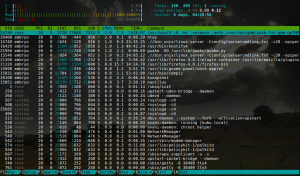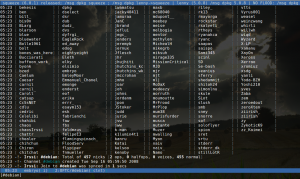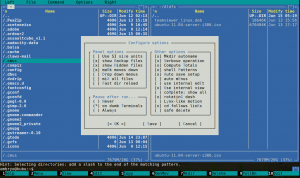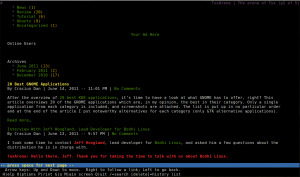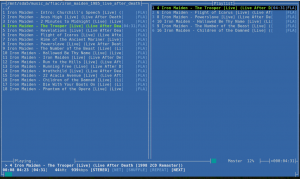cmus
cmus is a music player that I admire the most when it comes to command-line because it’s really powerful and has a lot of nice features. It is built with ncurses and therefore providing a text-user interface. cmus is indeed feature-rich, with several view modes and Last.fm song submission support via scripts. It supports Vi-like commands and auto-completion with Tab too. Recently I wrote a full guide on how to use cmus, you can read it here.
Homepage
finch
Finch comes bundled with Pidgin, the popular IM client. Finch offers the same functionality that Pidgin offers, only that it does it in a terminal by using the ncurses library. It supports IM protocols like Yahoo, Google Talk, XMPP (Facebook), WLM (Windows Live Messenger) and more. A while ago I put up a detailed guide to Finch, which you can read here.
Homepage
htop
htop is an interactive process viewer tool using ncurses which has the great benefit that it allows to scroll up and down the list of processes, and it also uses graphs and colors. I think all these make htop a real gem for the Linux user.
Homepage
irssi
Very powerful IRC (Internet Relay Chat) client with an ncurses-based interface, implements multi-server support, can be expanded with Perl scripts, supports themes, DCC chat and every other possible feature IRC servers allow.
Homepage
mc
Midnight Commander is the famous twin-panel file manager for the Linux terminal, also based on ncurses and with lots of features.
Homepage
lynx
lynx is a popular web browser for the terminal. It supports protocols like HTTP, FTP or Gopher.
Homepage
gzip
gzip is a command-line tool for compressing and uncompressing files. All the files that end in a .tar.gz extension are archived with tar and compressed with gzip.
Homepage
bzip2
Same as gzip, bzip2 is a data compressor which takes a longer time to compress and uncompress files, but it also provides a more efficient compression algorithm which results in smaller files.
Homepage
tar
This tool is used to create archived files, and will also work in conjunction with gzip or bzip2. The command to compress a file or folder to gzip is (what follows after # is a comment):
The c argument means compress, the z specifies the type of file to create (gzip file in this case), and f specifies the output file name. The command to uncompress a .tar.gz file:
This will extract the contents of input_file.tar.gz to the current working directory. Here are the commands for bzip2:
aaxine
aaxine is a video player for console based on xine-lib multimedia player, using ASCII characters for video output. In Ubuntu it is provided by the xine-console package.
Homepage
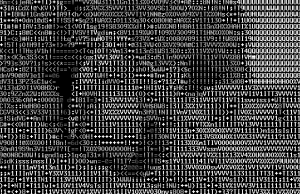
…it’s Big Buck Bunny by the way
aview
This tool allows to view images as ASCII art. It only supports the following formats, which are either in binary form or ASCII plain text: PNM, PGM, PBM, PPM. It also supports FLI and FLC video formats.
Homepage
mencoder
mencoder is a powerful video encoder and decoder included in MPlayer and can convert between various video files.
Homepage
ffmpeg
Using libavcodec, ffmpeg is yet another powerful tool to encode/decode, record and stream video files.
Homepage
convert
Included in ImageMagick, convert is a tool that can convert between image formats, and also apply various effects to images or edit certain aspects, including resizing, cropping, blur or dither effects. convert is also used on web servers for image processing.
Homepage
moc
moc (music on console) is yet another ncurses-based music player for the terminal which plays formats like Ogg Vorbis, FLAC, MP3, WAV or WMA. It also supports themes and searching for files.
Homepage
you forgot coreutils :D
interesting list, but by no means final: elinks for instance is a really easy to use and very functional browser, add bitlbee to irssi and you got IM and irc clients all in one, there’s a file manager called ranger that’s really interesting although i haven’t used it much, how about rtorrent? i love that program. i don’t know why, but i prefer top to htop, and i also use moc, but i’m very interested in reading that cmus guide. i’ve been having trouble lately with internet streaming on moc.
Cmus is a great choice for this list. Everyone should consider replacing their bloated, invasive media players with it, even if they have speedy rigs that could run 20 instances of Banshee.
Don’t forget the “multipliers”. Depending on the environment I run either Tilda or Yakuake, which are Quake style drop down terminals that are triggered by they F12 key. Then I run Screen. This allows me keyboard access to all my terminals whenever I need them. Just a quick F12 Alt-A-0 or F12 Alt-A-5 to get to the terminal I require.
HNB (HyperTextNotebook) is also a good app for keeping notes in.
I also prefer moc over cmus.
You have confused gzip and tar.
The command
[CODE]gzip -czf output_file.tar.gz input_dir [/CODE]
does nothing but produce an error message from gzip.
The flag “c” to tar means “create”. The correct usage is:
[CODE] tar gzip -czf output_file.tar.gz input_dir [/CODE]
to create a compressed tar file. The other two flags to tar are “z” meaning “compress with gzip” and “f” meaning “the output file name follows”.
You forgot vifm. Dual pane file manager with vi key bindings.
nzbget is a great terminal based usenet client
mutt as a great cli based email client
and finally never underestimate the power of:
tail -f
for your logfiles :)
All running via screen of course!
Thanks for this. Cmus is new to me, I’m def. gonna try it!
I would add the following:
– ncmpcpp (great music player client for mpd)
– rtorrent (the best bittorrent client imho)
Best regards.
multitail, mocp, rtorrent, iptraf, mutt
Dear Dan,
you may want to check why your articles are being cut by “adsweep” on both opera and Firefox.
mp3blaster
Terminator – Multiple GNOME terminals in one window
fish
This list is almost meaninless without SCREEN to run them all ;)
The screenshots were a nice touch. :)




